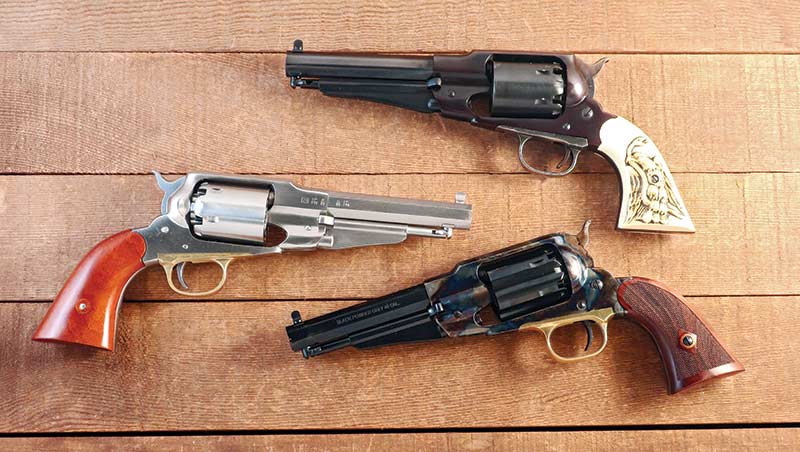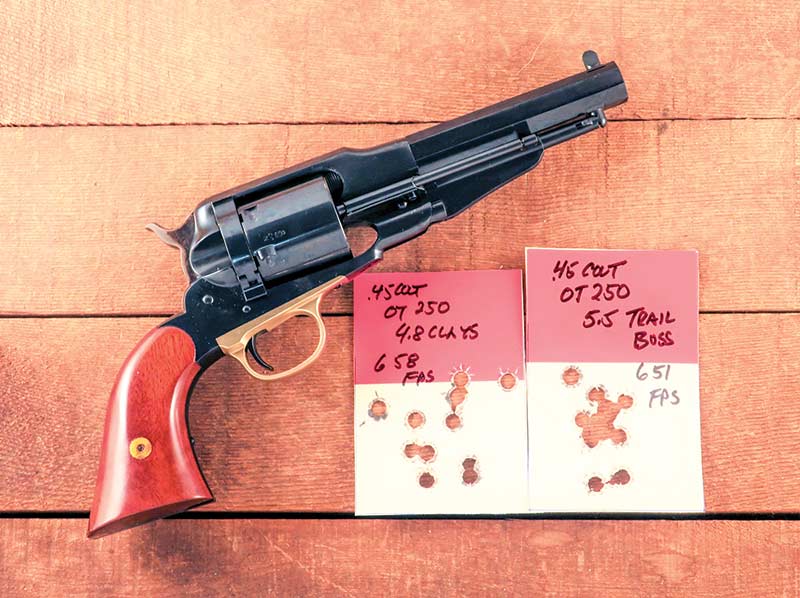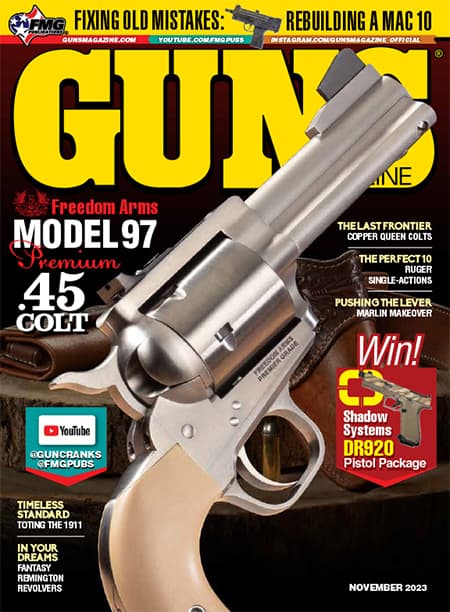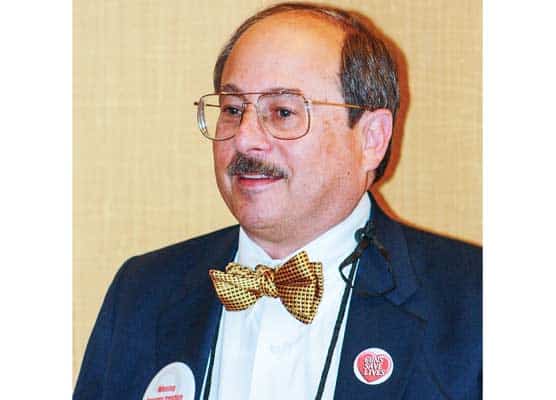Fantasy Remingtons
Current Replicas Aren't Faithful Copies — But Are Still Great!
Here in the opening quarter of the 21st century, we are blessed to have access to virtually all the 19th century single-action percussion revolvers produced by Remington and Colt. These come from such Italian firms as Pietta and Uberti now, and in the past from others such as Armi San Marcos and Armi Jaeger. My very first example in the late 1950s/early 1960s actually came from Belgium via Navy Arms. It was a Remington New Model Army, now mostly referred to as the Remington 1858 by the manufacturers. Yes, I wish I still had that one!
Current Crop
As we look at the different models being offered today, most of which were never offered originally, realize all sixguns mentioned have been offered in the past, are now in production or will be in the future. With so many models being offered, especially by the Italian manufacturers Pietta and Uberti, it is impossible to produce every model every day. In fact I have been waiting, with my name on several lists, for one particular model — a 12″ stainless steel .44 New Model Army from Pietta — for over two years now as this is written.
Long before Henry Ford and his Model T “could be had in any color as long as it was black,” .44 Remington New Model Army revolvers were available in any configuration desired as long as it was black with an 8″ barrel. Today, thanks to replicas, we really can have just about anything we want. These “Fantasy Models” never existed in the 18th century but current shooters have a large range of Remington models to pick from. Currently, barrel lengths offered are the original 8″, along with 5 ½” Sheriffs Models, 12″ Buffalo or Bison Models, and even a 3″ version known as the Ace. The selection of .36 New Model Remingtons is not even close, with only blued versions offered in barrel lengths of 7 ½”. I believe it is possible to find a .36 Sheriffs Model.
At least five different finishes are offered, although not with every barrel length listed above. These include standard blue, blue with a case-hardened frame, stainless steel, brass mainframe and even an Antique or Original finish that removes most of the bluing to give the sixgun a look of a 150-year-old revolver. All four of the above versions are available in blue, with the first three barrel lengths also offered in stainless steel as well as brass-frame versions.
In addition to standard models, several are available with adjustable sights. This includes all of the 12″ models and 8″ versions in both blue and stainless-steel configuration. A note on adjustable sights — whoever designed the Pietta rear sight must have been an experienced sixgunner as they are excellent sights with a square rear notch. The Uberti version is more traditional with the rear sight notch being more of a wide “U” shape. Sights are purely subjective; however, for my eyes, the Pietta works best.
I have found all Remington New Model Army replicas to be excellent shooters. I routinely make one change and that is replace the made-to-a-price factory nipples or cones, whichever you prefer to call them, with high quality stainless steel SliXshot nipples. These are shaped to better accommodate Remington #10 or Speer #11 percussion caps and are also vented on the side to help prevent cap jams.
Cartridge Conversions
In 1857, Smith & Wesson came forth with the first successful cartridge-firing revolver. This was a small-framed, seven-shot, tip-up revolver chambered in what we now know as the .22 Short. Smith & Wesson’s patent prevented anyone else from using the idea of a bored-through cylinder to accept cartridges. In February 1868, Remington and Smith & Wesson came to an agreement that allowed Remington to convert their New Model Army percussion six-shot sixguns to a five-shot revolver chambering the .46 Remington Rimfire. Nearly 4,600 were converted. By the second half of 1869, New Model Army revolvers were available with six-shot cylinders accepting what was then known as the .44 Centerfire Martin Cartridge.
By 1870-1871, the Remington Cartridge Conversion was available in .44 Colt Centerfire, which I assume to be the .44 Long Colt. A few .45 Cartridge Conversions have also been discovered and remaining cylinders will accept the .45 Colt. The .44 caliber cylinders accept the .44 Martin, .44 Remington and .44 Russian cartridges.
The Remington Navy Model revolvers were chambered in a .38 Centerfire, again which I assume to be the .38 Long Colt. The New Model Navy was offered in both rimfire and centerfire cartridges and as mentioned above, the Navy Model was slightly smaller than the Army Model, while today’s replicas use the same size frame.
Remington Cartridge Conversions are offered today with 5 ½” and 7 ½”/8″ versions in .38 Special, which also handles the .38 Long Colt quite well, and .45 Colt, which can also be used with the .45 Schofield round. All of the Remington Cartridge Conversions are rated for smokeless powder; however, only standard pressure loads should be used and with cast bullets.
All of the original Remington Percussion Pistols and Cartridge Conversions had main frames with a top strap and a grip frame that was an integral part of the mainframe. Everything is one-piece. Colt uses the open-top frame design with a removable barrel and a two-piece grip frame attached to the mainframe with screws. All replicas follow the same patterns.
For the Army trials of the early 1870s, Colt submitted their 1871-72 Open-Top and were sent back to the drawing board. They took a good look at the Remington solid frame and the resulting sixgun was the Colt Single Action Army .45 of 1873. Two years later, it was Remington’s turn to look at the Colt design and their answer was the Model of 1875. Remington maintained the solid one-piece frame and grip frame and also put a distinctive looking web underneath the barrel of their new cartridge firing sixgun.
The original Remington 1875 sixguns were chambered in .44 Remington and then, in 1878, Remington offered two more chamberings, the .45 Colt and the .44-44 (.44 Winchester Centerfire or WCF). Remington entered into bankruptcy in 1886 and was reorganized in 1888 as the Remington Arms Company. The final batch of 1875 Remington guns had 5 ½” barrels and, with the leftover parts from the Model of 1888, was assembled with the same barrel length and chambered in .44-40. The final Remington sixgun, the Model of 1890, was offered in barrel lengths of 5 ½” and 7 ½” but only one chambering, namely .44-40. Slightly only 2,000 are being manufactured. They are easily distinguished from the original Model 1875 as the web under the barrel is almost nonexistent.
Caliber Countdown
Today, replica Remingtons are offered in both the 1875 and 1890 Models with chamberings of .45 Colt, .44-40 and .357 Magnum. Both blued and nickel-plated versions are offered. For a very short time, Hartford Armory offered a high-quality Remington capable of handling .44 Magnum and heavy .45 Colt loads as well as some chambered in .44-40. One of the few complaints I have about any of the Remington models is the cramped space for my hand between the trigger guard and front strap. These Hartford Armory Remington took care of this and were very hand-friendly. Unfortunately, very few of these were made and I never did receive the pair I had ordered.
One big plus for the Remington percussion pistols and the cartridge-conversions is the sighting system. While the Colt has a rear sight which can only be accessed when the hammer is cocked, revealing a very slight V-shaped cutout in the top of the hammer, the solid-frame Remington has a rear sight cut in the top of the frame. This is just like the hog-wallow trough rear sight found on Colt Single Actions today, matched with a front sight in a dovetail allowing easy windage adjustment. The front sight is tall enough to allow it to be filed in to match point of aim and point of impact.
Remington replicas represent a good value and are often priced around ⅓ to ½ of what a modern cartridge-firing revolver or semi-automatic demands. However, when it comes to accuracy, they do not have to take a backseat to any so-called modern handguns and in fact will often outshoot them.










